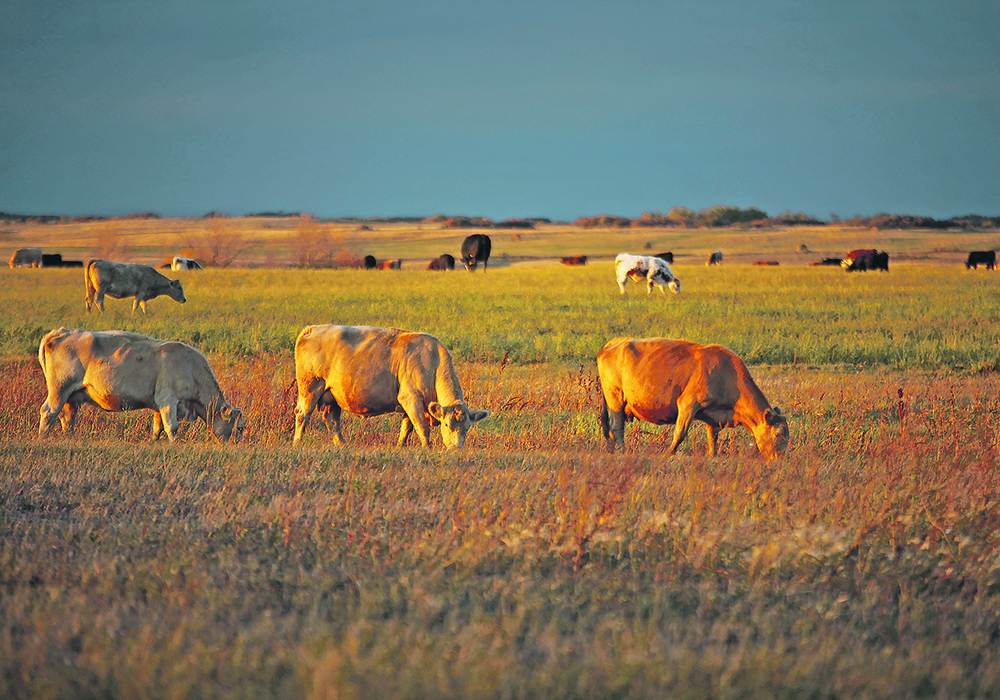A three-year tracking trial uses GPS and pedometers to find ways to encourage consumption of better quality forages
Free-ranging cattle on native pastures can sometimes have too much freedom and roam into places where forage is not the best quality.
New research on both sides of the Canada-U.S. border is focusing on how technology can be used to guide animals to the best feed available.
The U.S. Department of Agriculture recently published a research paper analyzing 10 years of field observations and satellite imagery in eastern Colorado to predict performance of cattle grazing.
In Canada, the University of Alberta is embarking on similar research during a three-year trial tracking grazing performance through GPS and pedometers.
Read Also

Pork sector targets sustainability
Manitoba Pork has a new guiding document, entitled Building a Sustainable Future, outlining its sustainability goals for the years to come.
Both projects are aimed at precision grazing and the development of virtual fencing to guide animals to the best forage.
“We’re basically trying to assess changing forage conditions throughout the grazing season, between seasons, make decisions based on how conditions are changing and then monitor outcomes over time,” said USDA researcher Sean Kearney.
Kearney said satellite data helped overcome the challenge of tracking forage and diet quality.
“The long-term research aspect of the team meant that there was a nice big data set to use, which is pretty unique to have on both diet quality and also cattle weight gain over such a long period of time and over multiple pastures,” he said.
That research showed ranchers were sometimes missing out on high quality grazing opportunities during years of early spring greening of pastures, leading to cattle spending more time on poorer quality grass.
While biomass in pastures was still plentiful later in the season, Kearney said missing out on earlier high-quality forage opportunities resulted in less weight gain.
He cautioned that the data remains localized to Colorado and might not be transferable to other regions.
But the initial results show there is value in taking it further afield.
“As we move into a climate regime that is outside what people have experienced, it becomes more important to have tools like satellite-based products to look at how things are changing and for ranchers and land managers to see how things are playing out differently in different locations,” said Kearney.
Even if growing seasons last longer and there is more annual moisture available, that doesn’t always translate into the best conditions for weight gain in cattle because forage quality and quantity don’t always match up, he said.
“You might be getting more of these types of years where diet quality peaks really early,” said Kearney.
Being able to use historical data to predict such changes isn’t a replacement for on-the-ground reading of conditions by pasture managers, he added.
But Kearney said it can provide another piece of the puzzle as the industry starts looking at virtual fencing as a way of managing cattle grazing.
Virtual fencing could see cattle guided to the best pasture through electric collars and GPS ear tags.
“Being able to have near real-time maps of forage conditions would tie in quite naturally with virtual fencing,” said Kearney.
That’s where University of Alberta researcher Edward Bork sees his three-year study in tracking grazing habits of cattle.
“We try to control where animals go, with what they do, how long they feed for or how much forage they remove through things like water availability, salting, mineral placement and of course cross fencing,” said Bork. “But there are alternative strategies that we might use in terms of where, when and how often animals graze.”
Bork’s study is using GPS ear tags and pedometers to track the grazing habits of cattle, exploring the possibility of utilizing the data for virtual fencing strategies to maximized weight gain, pasture use and conservation of rangelands.
“If we are confined by the use of structures like electric fences or permanent fencing — even though electric fencing is fairly convenient — it’s not instantaneous,” said Bork.
“But if we can create those paddocks, we can manipulate them in real time at will — so we can make those changes every eight, 12, 24, 48 hours on an as-needed basis — and do it virtually, that would be incredibly powerful.”
This system would be an especially good fit for short-grass ranges in semi-arid areas where pastures can be vast and actual fencing less efficient, said Bork.
While the virtual fencing shows promising results in Europe, Bork said there is work to be done in adapting the technology to western Canadian environments.
Cost is also another factor.
But within the next decade, Bork said he expects the technology and cost will make virtual fencing a real option for ranchers.
The ability to match pasture quality data with the technology to move cattle from a rancher’s kitchen table could be a win-win situation for cattle producers and the environment, he added.
“Making sure the right animal is in the right place at the right time to both get optimal weight gain, and therefore economic production, and at the same time not compromise the environment,” said Bork of the potential of the technology.


















